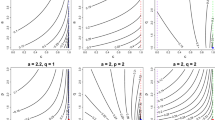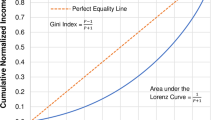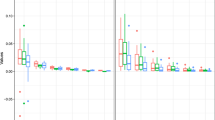Abstract
A large number of functional forms has been suggested in the literature for estimating Lorenz curves that describe the relationship between income and population shares. The traditional way of overcoming functional-form uncertainty when estimating a Lorenz curve is to choose the function that best fits the data in some sense. In this paper we describe an alternative approach for accommodating functional-form uncertainty, namely, how to use Bayesian model averaging to average the alternative functional forms. In this averaging process, the different Lorenz curves are weighted by their posterior probabilities of being correct. Unlike a strategy of picking the best-fitting function, Bayesian model averaging gives posterior standard deviations that reflect the functional-form uncertainty. Building on our earlier work (Chotikapanich and Griffiths, 2002), we construct likelihood functions using the Dirichlet distribution and estimate a number of Lorenz functions for Australian income units. Prior information is formulated in terms of the Gini coefficient and the income shares of the poorest 10% and poorest 90% of the population. Posterior density functions for these quantities are derived for each Lorenz function and are averaged over all the Lorenz functions.
Similar content being viewed by others
References
Andrews, D.W.K.: Hypothesis testing with a restricted parameter space, J. Econometrics 84 (1998), 155–199.
Australian Bureau of Statistics: Income Distribution 1997–98, Document No. 6523.0, Canberra, 1999.
Basmann, R.L., Hayes, K.J., Slottje, D.J. and Johnson, J.D.: A general functional form for approximating the Lorenz curve, J. Econometrics 43 (1990), 77–90.
Chotikapanich, D.: A comparison of alternative functional forms or the Lorenz curve, Economics Letters 41 (1993), 129–138.
Chotikapanich, D.: Techniques for Measuring Income Inequality, Avebury, Aldershot, 1994.
Chotikapanich, D. and Griffiths, W.E.: Estimating Lorenz curves using a Dirichlet distribution, J. Business and Economic Statistics 20(2) (2002), 290–295.
Datt, G.: Computational tools for poverty measurement and analysis, FCND Discussion Paper No. 50, International Food Policy Research Institute, World Bank, 1998.
Gelfand, A.E. and Dey, D.K.: Bayesian model choice: Asymptotics and exact calculations, J. Roy. Statist. Soc. Ser. B 56 (1994), 501–514.
Geweke, J.: Using simulation methods for Bayesian econometric models: Inference, development and communication, Econometric Reviews 18 (1999), 1–74.
Hasegawa, H. and Kozumi, H.: Estimation of Lorenz curves: A Bayesian nonparametric approach, J. Econometrics 115 (2003), 277–292.
Kakwani, N.C.: On a class of poverty measures, Econometrica 48 (1980), 437–446.
Kakwani, N.C. and Podder, N.: On estimation of Lorenz curves from grouped observations, International Economic Review 14 (1973), 278–292.
Kakwani, N.C. and Podder, N.: Efficient estimation of the Lorenz curve and associated inequality measures from grouped observations, Econometrica 44 (1976), 137–148.
Koop, G.: Bayesian Econometrics, Wiley, Chichester, 2003.
Ortega, P., Fernandez, M.A., Lodoux, M. and Garcia, A.: A new funational form for estimating Lorenz curves, Review of Income and Wealth 37 (1991), 447–452.
Rasche, R.H., Gaffney, J., Koo, A. and Obst, N.: Functional forms for estimating the Lorenz curve, Econometrica 48 (1980), 1061–1062.
Sarabia, J.-M., Castillo, E. and Slottje, D.J.: An ordered family of Lorenz curves, J. Econometrics 91 (1999), 43–60.
Spiegelhalter, D.J., Abrams, K.R. and Myles, J.P.: Bayesian Approaches to Clinical Trials and Health-Care Evaluation, Wiley, Chichester, 2004.
Tierney, L. and Kadane, J.B.: Accurate approximations for posterior moments and marginal densities, J. Amer. Statist. Assoc. 81 (1986), 82–86.
Author information
Authors and Affiliations
Rights and permissions
About this article
Cite this article
Chotikapanich, D., Griffiths, W.E. Averaging Lorenz curves. J Econ Inequal 3, 1–19 (2005). https://doi.org/10.1007/s10888-004-5866-2
Received:
Accepted:
Issue Date:
DOI: https://doi.org/10.1007/s10888-004-5866-2




